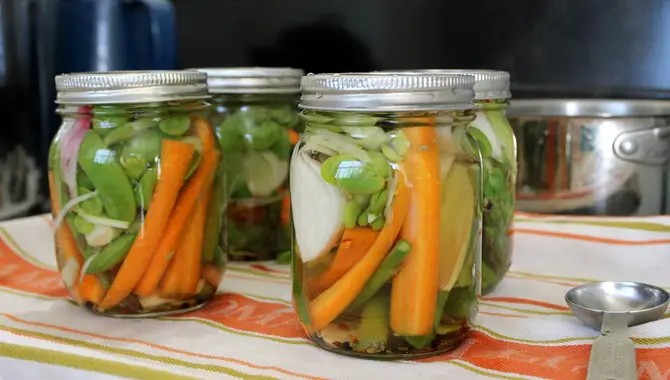Fermenting your own Korean kimchi at home can be a fun and rewarding experience. Kimchi is a traditional Korean side dish made from fermented vegetables, most commonly cabbage.
It is known for its tangy flavor and numerous health benefits. By fermenting kimchi, you can enjoy its delicious taste and harness the probiotic benefits of the fermentation process. We will share expert tips and tricks on how to ferment Korean kimchi like a pro. We’ve got you covered, from the essential ingredients you’ll need to the tips.
Additionally, we’ll explore the benefits of fermenting kimchi, including its impact on gut health and immune system support. We’ll also provide troubleshooting tips for common problems that may arise during fermentation. Get ready to elevate your culinary skills and indulge in the delicious world of homemade kimchi.

Essential Ingredients For Making Kimchi
To make kimchi, ensure you have the essential ingredients ready. Soak the napa cabbage leaves in salty water to make them flexible. Prepare the kimchi paste by combining radish, ginger, garlic, red pepper flakes, fish sauce, and salted shrimp paste. Rinse the cabbage leaves and spread the paste between each leaf.
Roll and fold the leaves, then store them in a jar or container. Ferment the kimchi at room temperature for a few days, then refrigerate it. This delicious kimchi is a versatile condiment that adds flavor to various dishes and serves as a healthy side dish.
How To Ferment Korean Kimchi: 5 Simple Tips

Fermenting Korean kimchi is a traditional method used to preserve and enhance the flavor of this popular Korean dish. Kimchi is made by fermenting vegetables, typically cabbage, with a mixture of salt, garlic, ginger, and red pepper flakes.
During fermentation, beneficial bacteria break down the sugars in the vegetables and produce lactic acid, giving kimchi its tangy flavor. Here are 5 simple tips to help you successfully how to ferment Korean kimchi. Following these simple tips, you can enjoy homemade Korean Kimchi full of flavor and packed with beneficial probiotics.
1. Use Fresh Ingredients
When fermenting Korean kimchi, using fresh ingredients is crucial for achieving the best flavor and texture. Fresh vegetables, such as napa cabbage, radishes, and carrots, provide the crispness and natural sweetness characteristic of traditional kimchi. It is also important to use fresh garlic, ginger, and onions for their aromatic flavors.
Additionally, using fresh chili powder or gochugaru is essential for adding the signature spicy kick to kimchi. By starting with fresh ingredients, you can ensure that your homemade kimchi turns out delicious and authentic. So head to your local market or grocery store to gather all the vibrant and flavorful ingredients you need to make a batch of mouthwatering Korean kimchi.
2. Prepare The Vegetables Properly

Properly preparing the vegetables is a crucial step in successfully fermenting Korean kimchi. Start by washing and cutting the vegetables into the desired size and shape. Traditionally, Napa cabbage is the main ingredient, but you can also incorporate other vegetables like radishes or carrots for added flavor and texture.
Once you prepare the vegetables, it’s important to salt them to draw out excess moisture. This helps create the perfect environment for fermentation and enhances the flavor of the kimchi. After salting, rinse the vegetables thoroughly to remove any excess salt before moving on to the next steps of the fermentation process.
3. Create A Flavorful Brine
Creating a flavorful brine is an essential step in fermenting Korean kimchi. The brine is what gives the kimchi its distinct tangy and spicy flavor. You will need a combination of water, salt, and seasonings to make the brine. Traditionally, coarse sea salt or kosher salt ensures proper fermentation.
In addition to salt, you can add ingredients like garlic, ginger, chili flakes, and fish sauce to enhance the flavor profile of your kimchi. The mixture should be dissolved completely before adding it to the vegetables for fermentation. By creating a flavorful brine, you can ensure that your kimchi has the perfect flavors to make it irresistible.
4. Pack The Jars Tightly

When fermenting Korean kimchi, it is important to pack the jars tightly to ensure proper fermentation. This helps create an anaerobic environment necessary for developing the tangy and flavorful taste that kimchi is known for. Start by adding a layer of kimchi to the bottom of the jar and press it down firmly with a spoon or your hands. Continue adding layers of kimchi, pressing each layer down tightly until the jar is almost full.
Leave a small amount of space at the top of the jar to allow for expansion during fermentation. Once the jars are packed tightly, close them with an airtight lid and store them in a cool, dark place for several days or weeks, depending on your desired level of fermentation.
5. Allow Time For Fermentation
Allowing time for fermentation is a crucial step when making Korean kimchi. Fermentation is what gives kimchi its distinct tangy and savory flavor, as well as its probiotic benefits.
After you have mixed all the ingredients and packed them tightly in a jar or fermentation vessel, it’s important to let the kimchi sit at room temperature for a period to allow the fermentation process to occur. You should leave kimchi to ferment for at least a few days up to a few weeks, depending on personal preference and the desired level of fermentation.
During this time, the flavors will develop and intensify, so be sure to taste them periodically until it reaches your desired level of tanginess. Once the fermentation process is complete, you can refrigerate your kimchi to slow down further fermentation and enjoy it as a delicious and healthy side dish or ingredient in various Korean dishes.
Benefits Of Fermenting Kimchi
Fermenting kimchi brings numerous benefits, elevating this Korean dish to new heights of flavor and nutrition. Beyond its amazing taste, fermentation enhances the umami richness of kimchi, infusing it with a depth of flavor that is hard to resist. Fermentation also introduces beneficial bacteria, supporting gut health and promoting optimal digestion and immune function.
Rich in lactic acid and other compounds, fermented kimchi may have anti-inflammatory and anticancer properties. You can store fermented kimchi in the fridge with its unique blend of spices, ensuring a ready supply for all your culinary adventures. Get ready to savor the goodness of authentic kimchi in every bite!
Troubleshooting Common Issues With Fermenting Kimchi

Fermenting kimchi can be a rewarding and delicious process, but it can also come with its fair share of challenges. If you’re experiencing issues while fermenting your kimchi, don’t worry – there are solutions. Here are some common problems that may arise during fermentation and how to troubleshoot them.
Remember, fermenting kimchi is an art that requires practice and patience. Don’t be discouraged by setbacks – with some troubleshooting and experimentation, you’ll soon be enjoying delicious.
- Mold growth: If you notice mold growing on the surface of your kimchi, it’s important to discard the entire batch. Mold can be harmful if consumed. To prevent mould growth in the future, use clean utensils and containers, keep your kimchi submerged in its brine, and store it in a cool, dark place.
- Over-fermentation: Kimchi fermented for too long can become overly sour or mushy. To avoid this, taste your kimchi regularly during the fermentation process. Once it reaches a level of tanginess that you enjoy, transfer it to the refrigerator to slow down the fermentation.
- Gas buildup: Sometimes, gases can build up during fermentation and cause the container to overflow or burst open. To prevent this, leave some headspace in your containers and briefly burp them daily by opening them to release any built-up gas.
- Slow fermentation: If your kimchi is not fermenting as quickly as expected, check the temperature of your fermentation environment. Kimchi ferments best at around 65-75°F (18-24°C). If it’s too cool, consider moving your containers to a warmer location or using a fermentation heater.
Conclusion
Fermenting Korean kimchi is a process that requires time, patience, and attention to detail. From preparing the ingredients to properly storing the finished product, every step plays a crucial role in achieving the delicious and tangy flavor that kimchi is known for.
Fermenting Korean kimchi is an art that requires patience and attention to detail. Following these expert tips and tricks, you can create delicious and flavorful kimchi that impresses your friends and family.
From understanding the benefits of fermentation to learning about the essential ingredients, this guide covers everything you need to know. And if you encounter any issues along the way, we’ve got you covered with troubleshooting tips. We hope you now understand how to ferment Korean kimchi.
Frequently Asked Questions
How Do Koreans Ferment Kimchi?
Koreans have a traditional method of fermenting kimchi by burying it in clay pots underground. This allows the kimchi to develop its flavours and achieve a tangy, slightly sour taste over several days or weeks. However, modern methods involve using airtight containers at room temperature or refrigeration for fermentation.
How Long Do Koreans Ferment Kimchi?
Koreans usually ferment kimchi for approximately 1-2 weeks, but the duration can vary depending on personal taste and desired tanginess. Factors like temperature and ingredients used can also affect fermentation time. Tasting the kimchi periodically is advisable to determine when it has reached the desired flavor.
What Should I Ferment Kimchi In?
Traditional ceramic crocks or glass jars with airtight lids are handy for fermenting kimchi. It’s important to use non-reactive containers like food-grade plastic or stainless steel. Ensure the container is clean and sanitized, and leave some headspace for fermentation gases.
How Do You Ferment Kimchi Quickly?
To speed up the fermentation process of kimchi, raise the temperature and add a bit of sugar. Pack the kimchi tightly in the jar to eliminate air bubbles and promote quicker fermentation. Check and taste it daily to gauge the desired level of fermentation.
What Is The Fermentation Process For Making Korean Kimchi?
Combine cabbage, radishes, and other vegetables with salt, garlic, ginger, and chili pepper flakes to make Korean kimchi. Let it ferment at room temperature for a few days. The natural bacteria break down sugars, producing lactic acid for the tangy flavor. Taste periodically to achieve desired sourness before refrigerating.

I’m a writer and blogger who loves to talk about entertainment, culture, and relationships. I love to share my thoughts and insights on these topics, and I’m always looking for new ways to engage with my readers. I’m also a big fan of learning new things, so I’m always exploring new areas of interest.
